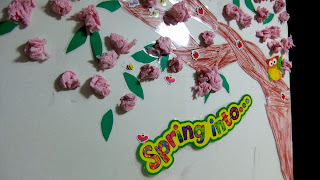This is my classroom. That is basically all of it. The table can be pushed back a few feet if it's standing. Like three feet maximum. Or, the table is collapsible and allows for more space for little kids class or active class. But it's still a small room and keeping those kiddos engaged week after week becomes a priority, and yet, no easy task at all.
I recall my predecessor telling me that the best part of the job is that no work comes home. That is not true. Even if I am not working I am always thinking of students: the good, the bad, the engaged, and the disengaged. Oh, genius-kid would love this. Or, I wonder if I can involve this problem student if I did such-and-such in class. My classes are small enough that I have all their names memorized, and even then, all my students have nicknames in my mind.
At any rate, this post is the first in, hopefully, a series that can help out other teachers of activities I have created for my classroom to help spice up classroom work for students who come see me week after week, some who have now been with me for upwards of a year and a half.
Today's Activity: Classroom Activity 1
Missing Parts Characters
What you will need:
-clipart of characters, a simple google image search will do you just fine
some topics which may be of interest: pirates, zombies, princesses, One Piece, Pokemon, blow up the image during printing
(You are not selling this, you are merely using it to engage student, let your imagination go wild or your target vocabulary drive this search, if you are studying clothes choose an image with interesting and complicated clothes and accessories. If you are teaching body parts, choose something a little more exposed. When students are engaged and curious about other items they might see, such as the pirate's sword or the zombie's brain, I find they become motivated to ask the vocabulary and retain it pretty well. )
-cardstock cards
-optional: laminator, laminator sheets
-scissors
-printer
This is the set I made for "Pirates", it reviews clothes, "bird", and face parts.
What I did:
-print out enough copies for your class plus one to show as the model image as the students try to piece the character together: I have maximum three students so I chose to go with three, plus one
-cut out the student characters, and then cut out various parts which clearly show target vocabulary, laminate the bodies and the cut out parts, the cut out parts are now game pieces which students will race to find under the card stock cards (you will need 8-10 cards, to have 8-10 items in play at a time)
-cut up cardstock for a size which generally fits over the body parts you cut out
The Game:
How to have fun with this in class
-elicit or teach new vocabulary with the full body image before beginning the activity and review I have/I don't have, or He/She/It has, doesn't have
-pass each student, or each group of students, their altered copy of the goal image. Encourage them to shout out "He/She/It doesn't have... (x)!" or "He/She/It has (x)!"
-tell students to close their eyes, and hide the various cut out parts, 8-10, depending on how many cards you cut out
-students only get one chance to look under a card, and must decide "He has/He doesn't have", each player or team gets a chance. When the game starts to reach its end some of the cards will be "empty"
-The first team to gather all it's missing parts wins! Routinely check in with students by eliciting what they still DON'T have so that they will know the vocabulary word to draw their card!
Some of my kids were scared of this one.
One of my Pirates, close up
One of my classes requested a "Stinky Baby" character
 Zombie edition
Zombie edition
Don't stress finding the perfect size image, they can easily be blown up and the kids will have fun with the game, not how perfect the image is
. The better you know your kids, the better you can make a game that will engage them! Just go wild.
Happy Teaching!
Corresponds to: English Land Level 2 Chapter 5
English Land Level 3 Chapter 3













.jpeg)



















